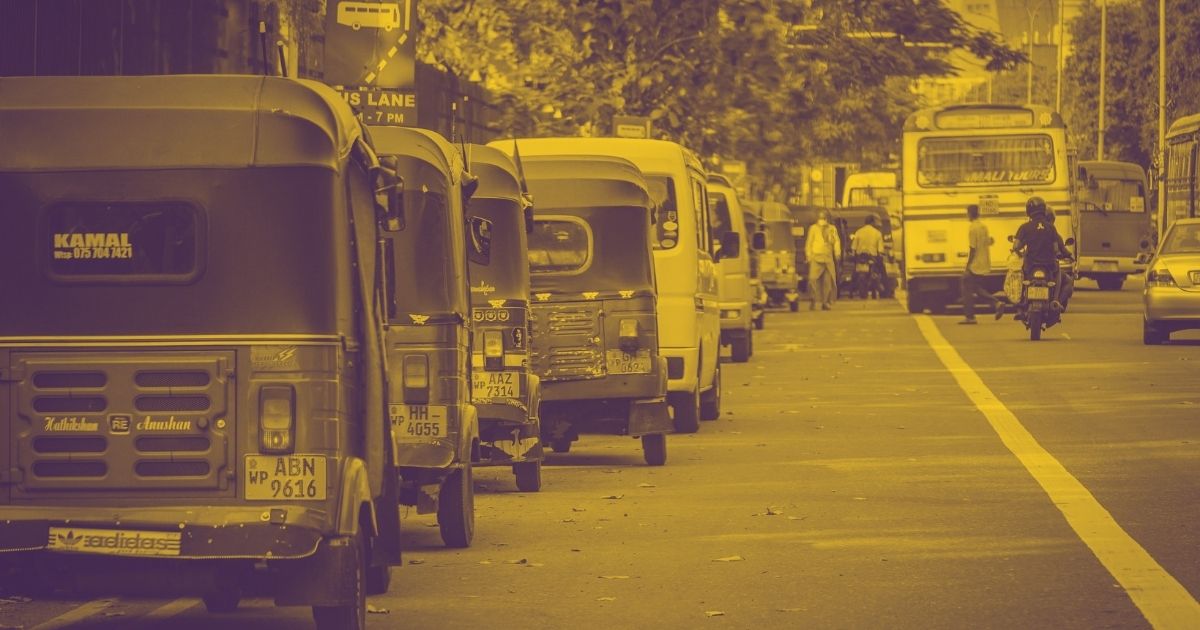Sri Lanka has not had a good year so far. The exchange rates have skyrocketed beyond the stratosphere, exams are postponed due to a paper shortage, and essential goods/medicines have run out. Amidst the resulting social unrest, public utilities have also been affected ranging from gas shortages to a full-blown fuel crisis.
While it started with 2-hour daily power cuts beginning sometime in the beginning of January, the issue has now spread to LPG gas stocks and fuel supply, causing lengthy queues to be formed outside Litro and Laughs outlets as well as fuel sheds.
The economic fallout has undoubtedly been massive, affecting everyone from small households to SMEs, with many of the latter having to close their doors in response.
Modern problems require modern solutions
Little has been done on the government’s end to alleviate the people’s plight where some of these efforts have taken on a more technical approach. For instance, the CEB powercut dashboard.
Existing as a web app accessible through the CEB website, the dashboard shows a simple map with outage areas highlighted. While rudimentary in design it was still quite welcome. The CEB care mobile app unveiled in 2019 has also been quite effective at the basics; notifying users of power cut schedules, repairs and enabling users to log breakdowns.
One can go so far as to say that this was one of the few instances where a ‘platform’ was properly implemented by a government institution.
While this solution proved effective and accurate at first, it has since become noticeably unreliable with power cuts becoming more Adhoc and zones being changed haphazardly.
This is very on par for the course as far as e-government projects are concerned. This brings us to the latest development announced by the (at the time of writing) minister of Energy and Power, Kanchana Wijesekera amidst the fuel crisis.
A new project
In a recent tweet, the minister noted that a platform was being made jointly with the ICTA to provide citizens with “information on availability of petroleum stocks at fuel stations islandwide”.
The proposition sounds quite welcoming. Thanks to the current fuel crisis, hours upon hours are wasted on fuel queues waiting for a bowser that may or may not arrive. Even then, there is no guarantee that you would be able to fill up since there are so many cars and only so much fuel. A digital platform can significantly reduce time wastage, via timely notifications and accurate details of the state of fuel sheds.
The tweet was accompanied by an image of an ICTA official showcasing a slide from what appears to be a pitch deck that was used to describe the system. While quite unsuspecting at first glance, upon closer inspection something seemed quite odd about that backend part of the system.
The slide shows a .csv file being uploaded to the ‘backend’ from the Ceylon Petroleum Corporation. For the uninitiated, a CSV file is not that different from a typical spreadsheet document one would open using Microsoft Excel.
If the slide is to be trusted (and with the complete lack of any other details about the proposed system) there is one major oversight of this implementation; a CSV file is static.
What this means is that it only provides a fixed overview of the fuel quantities received by each shed. It does not get updated with the state of fuel delivery, what amounts of fuel are remaining in the shed, or the varieties of fuel available. That is not unless the entire CSV file is replaced every time a new update comes along or someone manually and meticulously edits the file to the last detail.
Basically, the information it provides is of no use, except perhaps to the shed owners themselves. Unsurprisingly, a follow-up tweet seems to back this up.
How said station/shed managers are going to communicate this information to the general public remains unanswered. Now with the revised prices amidst this fuel crisis, these questions are important now more than ever.
The story beyond borders
The most notable case of a similar fuel crisis seen in recent history was the British fuel supply crisis in September 2021. Caused by a combination of factors like fuel hoarding and supply chain issues, the event saw bumper-to-bumper traffic lasting several weeks around the European nation.
Since the issue was resolved quickly, people simply resorted to using Google Maps and Waze to figure out which sheds had more traffic surrounding them. The more severe the traffic, the longer the queue. This Mcgyver-ish solution worked mainly because it was a temporary problem, and not one rooted in a severe economic crisis that had no end in sight.
Elsewhere, there are already discussions about building “smart fuel pumps” as in the case of India and Bahrain. The former talks about a more standard contactless payment system via an app that would make the process more efficient and self-serving whereas the latter delves into a more ambitious approach with even a robot involved to further streamline the experience.
However, both these approaches are driven by convenience and not a dire crisis. They do, however, showcase the viability of a ‘smart pump’ solution.
The fact remains an app can only resolve a distribution or scheduling problem, not the much larger issue at hand; simply not having enough fuel to go around. Therein lies a severe misunderstanding of how to solve problems using technology.
Which brings us to the ICTA.
I stands for Infamous
As its Wikipedia article details, the Information and Communication Technology Agency (ICTA) is the lead agency of Sri Lanka for implementing ICT initiatives by the Sri Lankan government. It claims its goal is to develop the Lankan economy through ICT.
To this end, the ICTA nor the government has the best track record when it comes to ‘e-government’ initiatives. What follows is a non-exhaustive list of several such projects that turned sour post-launch.
Stay-Safe app
Intended to curb the spread of the covid-19 pandemic through contact tracing, the stay-safe app was released to much fanfare in 2020. It worked via QR codes and SMS in a similar fashion to New Zealand’s contact tracing solution to the pandemic.
The issue arose however when Twitter users discovered that all submitted user data can be accessed via a simple API call. This included user names, addresses, and NIC numbers. While this prompted the ICTA to issue a patch post haste, it called into question their responsibility when it comes to handling confidential user data.
Crypto Committee
It’s understandable that the very mention of the word ‘crypto’ draws derision. The term itself has been marred with countless scams and get-rich-quick schemes with numerous influencer personalities caught in the scandals.
Despite this, the technology does have genuine advantages and the Lankan government wanted to cash in on it (pun intended). In a tweet posted late 2021, the then State Minister of Digital Technology and Enterprise Development, Namal Rajapaksa stated that the country “…is taking a leap forward today as the cabinet approves to establish a committee propose policy on BlockChain Technology, Digital Banking & Crypto Mining.”
As always it remains unclear how exactly this committee is going to tackle the introduction of crypto into an already beaten economy, nor how they are going to circumvent the massive energy issues posed by the technology given the country’s already strained power grid.
MFA system failure
In November of 2021, a breakdown of the Foreign Ministry’s Electronic Document Attestation System (e-DAS) caused pandemonium at their office. Introduced initially as a way to improve efficiency when handling document attestation, the system has been marred with problems since 2019.
Ironically the solution won the ICTA’s e-Swabhimani award under the Government & Citizen Engagement category in 2017. While a favorite with the jurors, as the people inconvenienced at the Foreign Ministry office would attest; the actual implementation left a lot to be desired.
The horse you once rode in on…
Google Loon is the steed that has been beaten to death so many times by now it’s basically graduated into an internet meme. So I’ll pay my respects and leave a link for those who are curious.
Being realistic about mitigating the fuel crisis
If such a platform were to be implemented properly, it would require real-time data to be fed into the ‘backend’ and subsequently sent to the ‘frontend’ where the public can access that data via SMS, a mobile app, or a website.
The real-time data feeding part can be done either manually or automatically. The former being a shed attendant entering each individual transaction into the system and the latter being a ‘connected smart fuel pump’ transmitting each transaction as it happens, without any human intervention.
Below is my professionally drawn diagram of what I believe an implementation could look like:
Is this impossible? Absolutely not. As we saw earlier, it’s actually even being considered by others.
However, it would be costly, as capital would be needed to invest in extra hardware for IoT (Internet of Things) connected pumps. Capital that would need to be sourced from public funds. But the point is that a solution such as this would be sustainable and future-proof. In the long run, the taxpayers would actually reap the rewards in the form of saved time.
In fact, there are local companies who claim to have expertise in this domain already who’ve made similar ‘connected’ public utility hardware such as IoT electricity meters and EV charging stations.
So, what’s stopping the ICTA from partnering with them?
Closing thoughts
In March of 2022, then State Minister of Digital Technology and Enterprise Development, Namal Rajapaksa published a “comprehensive roadmap” in the form of a medium article detailing how he plans to take Sri Lanka digital.
The document elaborated his thoughts on digitalizing the sports ministry, connecting AG’s divisions/Pradeshiya offices through a unified platform, and of course “plans” to introduce Bitcoin and altcoins to the mainstream financial systems among other things.
It unsurprisingly lacked any depth and any mention of more prominent, long overdue matters such as internet connectivity in rural areas so students can attend virtual classes or the digitalization progress of public transport infrastructure, especially ticketing services. Namal’s plan talks about “going virtual” when even our current parliament cannot properly settle on using Zoom to convene during an unprecedented economic crisis. But most importantly, the self-described roadmap lacked the most vital part of any roadmap — clear deadlines and goals.
This leads us back to the original conundrum, a severe misunderstanding of how to solve problems using technology. However, on closer inspection it appears that there’s a severe misunderstanding of the problems themselves.
What the citizens of Sri Lanka really need right now aren’t more empty platitudes in the form of apps and platforms, but rather 24 hours of electricity, a consistent fuel supply, and a government that gives a damn about its people. One that can formulate a plan of attack to get us out of their self-inflicted mess.
All the digital transformation and e-government initiatives in the world wouldn’t make a lick of sense if it’s not based on a stable political foundation, one of a government that strives to serve its’ people.







Everyone in power wants to steal. Can we mention one good government digitalization project? ICTA, the software company is just an absolute useless government agency, no idea why they even do exist. Instead of making gov policies and connecting gov departments, ICTA does everything other than this task which they should be doing.
It’s a shame to even talk about these projects while we promote ourselves as the best technology destination.
What the CPC needs is a fucking ERP, not an ad-hock system!
ICATA’s role is very important, but are they playing an important role from tax payers money is a big question.
How much do we need to run ICTA for a year? It’s our money and what do they do? Write speeches for the digital minister? readme why don’t you guys put a rti and find out the amount spent to run this icta.
That’s a very good idea. Can we look a 5 year timeline and see what actually ICTA has done, expenditure vs return and audit all the failed projects. This could be another GOV agency that’s wasting money.